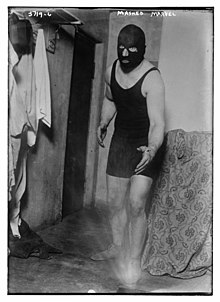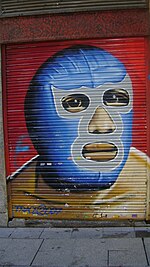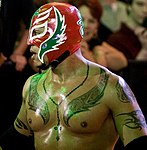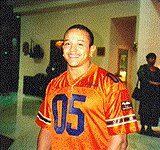Wrestling mask

A wrestling mask is a fabric-based mask that some professional wrestlers wear as part of their in-ring persona or gimmick. Professional wrestlers have been using masks as far back as 1915 and they are still widely used today, especially in Lucha Libre in Mexico.
History
At the 1865 World's Fair, Theobaud Bauer debuted the mask, wrestling as "The Masked Wrestler" in Paris, France. He continued wrestling using the mask throughout France as part of a circus troupe in the 1860s before moving on to the United States in the early 1870s.[1]
December 14, 1874, The Charlotte Democrat reported on an interesting story from Bucharest Romania about an open challenge made by local wrestler, Jules Rigal being accepted by a gentleman wishing to remain anonymous. The gentleman was a masked wrestler named "The Great Unknown," and rumored to have been Prince Stourja, a Moldavian nobleman with a reputation of Herculean strength. The success of this match lead to the several successful nightly rematches between the two opponents. Until one night a talkative member of the troupe let it slide that "The Great Unknown" was another clown from this circus. The Bucharest crowd became aware of this and lead to a disturbance that cause "The Great Unknown," the manager, and their troupe to narrowly escape being torn apart by the crowd. The police succeeded in suppressing, what seemed, to be a serious riot brewing that night. This event being the earliest documented masked wrestler in Romania and the earliest pro wrestling riot [2]
In 1915, Mort Henderson started wrestling as the "Masked Marvel" in the New York area making him the earliest North American wrestler to perform with such a gimmick. In the subsequent years many wrestlers would put on a mask after they had been used in an area, or territory, that their popularity and drawing ability diminished, it would be an easy way for a wrestler to begin working in a new area as a "fresh face". Sometimes workers wore masks in one territory and unmasked in another territory in order to keep their two identities separate.

The mask in the US and Canada
Many wrestlers have had very successful careers while masked such as The Destroyer/Dr. X, Mr. Wrestling, Masked Superstar and the Spoiler. In the days where professional wrestling was more regional, with less national television coverage, it was not uncommon for more than one person or team to use the same gimmick and mask, and there have at times been several masked "Interns", "Assassins" and "Executioners" working simultaneously. Tag team wrestling has seen more masked teams, using identical masks to create unity between wrestlers. Successful masked teams include the Masked Assassins, Blue Infernos and the Grapplers.
One of the best-known North American masked wrestlers was Big Van Vader, who was also known for his in-ring agility despite his large frame during the 1980s and 90s. Other notable examples are Rey Mysterio, Mankind, Kane, Doom, Edge & Christian as 'Los Conquistadores' & Owen Hart as 'Blue Blazer'.
Today, masked wrestlers are not a common sight in the United States and Canada, but masked wrestlers have a long history in that region, dating back to 1915. A mask sometimes will be used by a well known wrestler in a storyline where they must get around various "stipulations" or betray a trust without revealing their true identity. For instance wrestlers who are suspended in a storyline return under a mask under another name, usually with it being very obvious who is under the mask. Examples of this include: Hulk Hogan as Mr. America, Dusty Rhodes as The Midnight Rider, André the Giant as Giant Machine, Brian Pillman as The Yellow Dog, The Miz as The Calgary Kid, Dan Marsh as Mr. X and Bo Dallas as Mr. NXT. Jimmy Valiant once returned under a mask as Charlie Brown from Outta Town after losing to Paul Jones in a "Loser Leaves Town" match (a stipulation where the loser of the match must resign from the organization for which he worked). Mickie James also revealed to be under the mask when she returned to WWE as Alexa Bliss's partner.
The mask in Lucha Libre
When I put on the mask, I'm transformed. The mask gives me strength. The mask gives me fame. The mask is magical. When I remove the mask, I'm a normal human who can walk right by you, and not even get a "hello". Usually with the mask on, everything is positive. Without the mask I'm a normal being who has his problems, who cries, who sometimes suffers. I could tell you that I really admire El Hijo del Santo. But do you know who I admire more ? The human being. Thanks to him, El Hijo del Santo has a life. And this human being sometimes sacrifices a lot to give this other identity life.
— El Hijo del Santo, [3]
The Luchador mask, known as a mascara in Spanish, “draws from Mexican history in which Mayans and Aztecs warriors would complete for superiority”.[4] The style of the masks represent “animals, gods, mythological figures and other elements of Mexican folklore”.[5]
"The mask is the luchador's identity, both in and out of the ring. Luchadores will keep their faces and real names a secret throughout their entire lives; some of the more iconic luchadores have even been buried in their mask."[5]
WWE hall of famer El Santo is one of the most iconic luchadores. He “helped fuel the growth and reputation of lucha libre throughout the world”.[6] “WWE Hall of Famer Eddie Guerrero once wrote that ‘Calling him a legend doesn’t even do justice to how big he was. In his heyday, Santo was bigger than Hulk Hogan and ‘Stone Cold’ Steve Austin combined’”.[7]
The Mexican fanbase quickly took to the mystery of the masked man and soon after, Mexican wrestlers themselves started wearing masks, becoming "enmascarados". Early masks were simple with strong, basic colors designs that could be recognized even in the back row of the arena. Over the years, the masks evolved to become very intricate and colorful, drawing on Mexico's rich history.

Lucha Libre is still an incredibly popular sport in Mexico, with souvenir masks being sold at events and online. Masks are colorfully designed to evoke the images of animals, gods, ancient heroes, and other archetypes, whose identity the luchador takes on during a performance. Most wrestlers in Mexico start their career wearing a mask, but over the span of their careers, a substantial number of them will be unmasked. Sometimes, a wrestler slated for retirement will be unmasked in one of his final bouts or at the beginning of a final tour, signifying loss of identity as that character. Sometimes, losing the mask signifies the end of a gimmick, with the wrestler moving on to a new gimmick and mask, often without public acknowledgement of the wrestler's previous persona.
The wrestling mask is considered "sacred", so much so that the intentional removal of a mask is grounds for disqualification. If a wrestler is unmasked during the match, his top priority is to cover up his face and they usually get help from people at ringside to do so. Most masked wrestlers wear their masks for any and all public appearances, using the mask to keep their personal life separate from their professional life; because of the mask, most Mexican wrestlers enjoy a higher degree of anonymity about their personal lives. Some wrestlers become larger-than-life characters, such as El Santo, one of the most popular cultural icons who always wore his mask in public, revealing his face only briefly in old age, and was even buried in his trademark silver mask.
Luchas de Apuestas
In lucha libre, the highest achievement is not winning a championship but winning the mask of an opponent in a luchas de apuestas, a "bet fight" where each wrestler bets their mask. The luchas de apuestas is usually seen as the culmination of a long and heated storyline between two or more wrestlers, with the winner getting the "ultimate victory". It is customary for the loser of such a match to reveal his real name, where he's from and how long he has been a wrestler before taking the mask off to show his face. Unmasked wrestlers will wager their hair instead, risking having his or her head shaved bald in case of defeat. There can be several reasons to book a luchas de apuestas beyond the obvious purpose of elevating the winner. If the loser is a younger wrestler, then the loss of the mask can sometimes lead to a promotional push after unmasking, or the wrestler being given a new ring persona. Older wrestlers often lose their masks during the last couple of years of their career, often for a big payday depending on how long and successful a career they've had; the more successful the wrestler that's unmasked, the bigger the honor for the winner.
The first luchas de apuestas match was presented on July 14, 1940 at Arena México. The defending champion Murciélago was so much lighter than his challenger Octavio that he requested a further condition before he would sign the contract: Octavio would have to put his hair on the line. Octavio won the match and Murciélago unmasked, giving birth to a tradition in lucha libre.[8]

High-profile luchas de apuestas include El Santo winning the mask of Black Shadow, Los Villanos winning the masks of all three Los Brazos (El Brazo, Brazo de Oro and Brazo de Plata), Atlantis winning the mask of Villano III, La Parka unmasking both Cibernético and El Mesias, Villano V taking Blue Panther's mask and Último Guerrero winning the mask of Villano V. Some wrestlers have made a career by the volume of masks they have won rather than the general quality of their opponents—wrestler Super Muñeco claims to have won over 100 masks, with at least 80 verifiable luchas de apuestas wins, while Estrella Blanca is said to have the most luchas de apuestas, with over 200 masks won.
The mask in Japanese wrestling
The Destroyer, an American, was the first masked wrestler to work in Japan during the 1960s but remained a novelty with very few Japanese wrestlers choosing to wear a mask. The first Japanese masked wrestler is considered to be Shozo Kobayashi, who briefly competed under a mask as Fukumen Taro ("Masked Taro"). In the 1970s Mil Máscaras became the first Mexican Luchador to work on a regular basis and became very popular with the fans. The original Tiger Mask, Satoru Sayama was inspired by Mil Máscaras to create the masked "Tiger Mask" persona. After the success of Tiger Mask several wrestlers have adopted the mask, mainly lighter wrestlers who like Sayama had a more high flying and flashy style. The wrestling mask is held in more regard by the Japanese fans than the North American fans but isn't as "sacred" as the Mexican mask, meaning that the wrestler can perform both masked one day and unmasked another if he so wishes. Famous Japanese masked wrestlers include Jyushin Thunder Liger, Último Dragón, El Samurai, The Great Sasuke, Dragon Kid and Bushi.
The mask in British wrestling
Although at live shows, masked wrestlers were as prolific in British wrestling as its American counterpart, they were largely kept off ITV's television coverage until the late 1960s. Successful masked wrestlers up until this point included Count Bartelli (Geoff Condliffe), the White Angel (Judo Al Hayes) and Doctor Death (promoter Paul Lincoln as the top villain of his own major independent promotion). Masked wrestlers were frequently disparaged by top promoters during this period as a symptom of the allegedly "anarchic" conditions in American wrestling - indeed the first masked wrestler on ITV, The Outlaw (Gordon Nelson) was announced as being an American.
The most famous masked wrestler in British history, Peter Thornley, the original British version of Kendo Nagasaki, made his professional debut - complete with masked Samurai gimmick - in 1964 but did not appear on television until 1971. Nagasaki's first big victory was a win over mentor (and real life trainer) Bartelli in a 1966 mask vs mask match. His own mask was pulled off by opponent Big Daddy during a televised match in December 1975, an important turning point in Daddy's rise in popularity. Nagasaki later voluntarily unmasked in a ceremony in the ring on TV in December 1977. By 1986 he was back under the mask and was the top villain of All Star Wrestling from this point until his second retirement in 1993.
Another successful masked wrestler from the 1970s was blue-eye martial artist Kung Fu, played by Eddie Hamill, who lost his mask after a 1976 televised defeat by Mick McManus[9] but continued to wrestle unmasked still as Kung Fu, winning the British Heavy Middleweight Championship in 1986.[10]
At Christmas 1979, Big Daddy defeated and unmasked Mr. X on television. Subsequently, during the 1980s in Joint Promotions, masked wrestlers were generally built towards being fodder for Big Daddy to defeat, unmask and humiliate in headline tag matches on ITV, such as the Spoiler (Drew McDonald) King Kendo (aka Red Devil), Battle Star, El Diablo, the Black Baron, the Masked Marauders tag team and The Emperor. Meanwhile in All Star Wrestling - apart from Nagasaki - they were mostly treated as short lived reflections of recent fads in popular culture. In 1995, All Star shows were frequently headlined by a masked tag team based on the Power Rangers franchise, until the copyright owners intervened. In the 21st century, El Ligero wrestled successfully for both the traditional and American-style promotions.
The mask in French wrestling
Bauer as the Masked Wrestler of Paris in the 1860s, would be followed by more masked wrestlers in his home country. A wrestling mask was known in France as a "cagoule" (hood) and fans would often chant "he he la cagoule" to encourage the babyface to unmask a masked heel. Doing so, however, was banned under French wrestling rules - if unmasked, a wrestler would crouch on the mat face-down until the referee restored his mask.
One of the earliest successes of televised wrestling in France was the feud between babyface masked wrestler L'Ange Blanc,[11] and black clad heel masked wrestler Le Bourreau de Bethune[11] Another successful masked heel of the 1960s was L'Homme Masqué (The Masked Man). Spanish wrestler Angelito initially wore a silver mask in France before taking it off midway through a 1971 televised match with Jacky Richard. Another Spaniard, Oscar "Crusher" Verdu, who wrestled under a mask as Der Henker, would win the French Heavyweight Championship in 1983.[12] British wrestler Dave Larsen wrestled in France under a mask as Zarak. In the 1980s, masks were primarily worn as a component of more outlandish characters such as the tag teams Les Piranhas and Les Maniaks (a team of evil masked clowns) and Mambo Le Primitiv, based on the film character of King Kong. This tradition continued in the early 21st century with Cybernic Machine, a masked wrestler playing a "computer virus" character, who was a successful heel in France.[13]
Anatomy of the wrestling mask
The original wrestling masks were often masks attached to a top that snapped in the groin making it very uncomfortable for the people wearing it. If the masks were not attached to the top, then they were made from uncomfortable material such as brushed pig skin, leather or suede. In the 1930s, a Mexican shoe maker called Antonio Martinez created a mask on request from Charro Aguayo that became the standard for wrestling masks created since then. The basic design consists of four pieces of fabric sewn together to create the basic shape that covers the entire head. The mask has openings for the eyes, nose and mouth with colorful trim around the open features, known as "Antifaz" in Spanish. The back of the mask is open with a "tongue" of fabric under laces to keep it tight enough to not come off accidentally during a match. The first variation in style came when the jaw and mouth area was removed from the mask to expose the skin. Other masks have solid material over the mouth, nose, eyes or all three, in the case of fabric covering the eyes a stretched fabric that is see through up-close is used.
Originally being made from fabric, masks have evolved and are now made from a variety of materials from cotton to nylon to various vinyl polymers in many different colours and patterns. Several additions have been made to the mask decorations over the years with the most prevalent and visually striking being foam horns and artificial hair attached to the mask. Mock ears are also commonly used, especially if the mask has an animal motif such as a tiger and other animals.
See also
References
- General
- Madigan, Dan (2007). Mondo Lucha Libre: the bizarre & honorable world of wild Mexican wrestling. HarperCollins Publishers. ISBN 978-0-06-085583-3.
- El Nacimiencito de un Sueño (the birth of a dream), Pages 41 - 51
- Masks, Pages 46-49
- The Mask in the match, Pages 60-61
- Los Enmascarados (the Masked Men), Pages 71-127
- Ranjan Chhibber (2007). "Lucha in the '80s and the demise of the masked Mexican wrestler in America". Mondo Lucha Libre: the bizarre & honorable world of wild Mexican wrestling. HarperCollins Publishers. pp. 133–137. ISBN 978-0-06-085583-3.
- L.L. Staff (2007-11-05). "Lucha Libre: Revista de Mascaras" (in Spanish). Mexico. pp. 1–65. Mascareros Forjadores de Leyendas.
- Stacy Brandt (2002-12-05). "Who Was That Masked Man?". The Daily Aztec. Archived from the original on 2009-02-12. Retrieved 2009-04-05.
- Greg Oliver & Steve Johnson (2005). The Pro Wrestling Hall of Fame: The Tag Teams. ECW Press. ISBN 978-1-55022-683-6.
- The Assassins, Pages 52-54
- The Interns, Pages 76-78
- The Infernos, Pages 199-201
- The Mysterious Medics, Pages 213-215
- Mr. Wrestling I & II, Pages 231-232
- Specific
- ^ Shoemaker, David (2013). The Squared Circle: Life, Death, and Professional Wrestling. Penguin. p. 69. ISBN 978-1592407675.
- ^ Humanities, National Endowment for the (1874-12-14). "The Charlotte Democrat. [volume] (Charlotte, N.C.) 1870-1881, December 14, 1874, Image 1". ISSN 2372-3181. Retrieved 2024-12-14.
- ^ ESPN Interview Born + Raised: El Hijo del Santo Spanish version[dead link]
- ^ "The history of the lucha libre mask traces back hundreds of years". ABC7 Los Angeles. Retrieved 2024-08-08.
- ^ a b Bergeron, Ryan (2015-04-22). "Behind the luchador mask". CNN. Retrieved 2024-08-08.
- ^ Echegaray, Luis Miguel (2016-09-23). "El Santo, legendary Mexican wrestler, commemorated in Google doodle". The Guardian. ISSN 0261-3077. Retrieved 2024-08-08.
- ^ "El Santo". WWE. Retrieved 2024-08-08.
- ^ Lourdes Grobet; Alfonso Morales; Gustavo Fuentes & Jose Manuel Aurrecoechea (2005). Lucha Libre: Masked Superstars of Mexican Wrestling. Trilce. p. 115. ISBN 978-1-933045-05-4.
- ^ "Itvwrestling.co.uk - 1976".
- ^ Duncan, Royal; Will, Gary (2000). "Europe - Great Britain: British Heavy Middleweight Title". Wrestling title histories: professional wrestling champions around the world from the 19th century to the present. Pennsylvania: Archeus Communications. p. 403. ISBN 0-9698161-5-4.
- ^ a b "Le catch casse la baraque". leparisien.fr. December 9, 2008.
- ^ "French Heavyweight Title".
- ^ "Cybernic Machine, Hells Frightful Creature". www.cagematch.net.
Further reading
- Enciclopedia de las Mascaras, 11 volume magazine published 2007 - 2008. Covers the technical aspects of various luchador's masks from A to Z, details on fabric, construction, design and manufacturing.


